Plane Table Surveying
What is Plane Table Surveying?
The plane table looking over is the quick technique for studying. In this kind of reviewing plotting of the arrangement and field perceptions should be possible all the while. If there should be an occurrence of plane table reviewing Geometrical states of site are original copy in the guide sheet utilizing plane table and alidade after that topographic subtleties are organized on the guide.
Plane Table Surveying Method :
The guideline of plane postponing is parallelism, implying that the beams attracted from stations to objects on the
Paper are corresponding to the lines from the stations to the items on the ground. The general places of the
Items on the ground are spoken to by their plotted situations on the paper and lie on the particular beams. The table is constantly positioned at every one of the progressive stations corresponding to the position it involved at the beginning station. Plane postponing is a graphical strategy for looking over. Here, the field work and plotting are done at the same time and such review doesn't include the utilization of a field book.
Plane table review is essentially reasonable for filling inside subtleties when navigating is finished by theodolite. At times navigating via plane table may likewise be finished. In any case, this review is suggested for the work where extraordinary exactness isn't required. As the fitting and fixing course of action of this instrument isn't great, most exact work can't be normal.
Paper are corresponding to the lines from the stations to the items on the ground. The general places of the
Items on the ground are spoken to by their plotted situations on the paper and lie on the particular beams. The table is constantly positioned at every one of the progressive stations corresponding to the position it involved at the beginning station. Plane postponing is a graphical strategy for looking over. Here, the field work and plotting are done at the same time and such review doesn't include the utilization of a field book.
Plane table review is essentially reasonable for filling inside subtleties when navigating is finished by theodolite. At times navigating via plane table may likewise be finished. In any case, this review is suggested for the work where extraordinary exactness isn't required. As the fitting and fixing course of action of this instrument isn't great, most exact work can't be normal.
Used in Plane Table Survey -
- Plane table
- Alidade for sighting (telescopic or simple)
- Plumb bob and plumb fork
- Compass
- Spirit level
- Chain
- Ranging rods
- Tripod
- Drawing sheet and drawing tools
- Paper clips or screws
Temporary Adjustments of The Plane Table -
1. Centering :
This procedure is to determine that the point on the ground is spoken to precisely on the paper. It is completed with the assistance of plumbing fork and plumbing bob.The pointed end (at the high ground) of the pipes fork is kept on paper and at the opposite end, a plumb weave is fixed. The board is moved physically until the weave hangs precisely over the peg of the station. This work can be tedious however an essential for any further exercises.
2. Leveling :
The table is leveled by setting the soul level at various corners and different situations on the table.
Leveling is done so the planning phase stays corresponding to the ground. It is done in the accompanying three techniques:
conventional inclining the board
by ball and attachment game plan or
by altering the legs of the tripod.
Leveling is done so the planning phase stays corresponding to the ground. It is done in the accompanying three techniques:
conventional inclining the board
by ball and attachment game plan or
by altering the legs of the tripod.
3. Orientation :
The procedure by which the position involved by the board at different overview stations are kept equal is known as the direction. In the plane table reviewing, the entire table should be moved at a few stations to finish a study. Each time the table is moved one needs to ensure that the new station is corresponding to the past one in any case the lines drawn on paper won't speak to similar lines on the field. Techniques for direction are:-
- Orientation by Magnetic Needle:
- This technique is utilized when it is preposterous to expect to cut up the past station from the new station. This strategy isn't a lot of dependable and inclined to mistakes because of varieties of the attractive field.
- Orientation by Back Sighting:
- This is an increasingly solid strategy. In this technique, a specific line drawn from the past station is drawn again from the new station. This procedure is gotten back to locating. One doesn't really need to adhere to a meaningful boundary the subsequent time rather check if the new line superposes over the past one or not.
Methods of Plane Table Surveying -
Radiation :
Strategy It is the easiest technique for plane table studying. This technique is just powerful if the entire reviewing is to be done from one single station for example the table will be in such a situation from where the various purposes of the field are effectively noticeable. The technique is as per the following:
A point P is to be chosen in such a style, that the various focuses ( A B C D E) are seen effectively from P.
Focusing, leveling, and direction must be done before looking over.
From the outset, by putting the alidade on point P a view for station An is to be drawn.
In the wake of estimating the separation of PA on field, the estimation should be written down to an appropriate scale.
Also, focuses b, c, d, and e are gotten on paper by drawing views for stations B, C and D and estimating the separations PB, PC, PD and PE on ground individually.
Focuses a, b, c, d, and e are joined on paper, as appeared in the figure.
A point P is to be chosen in such a style, that the various focuses ( A B C D E) are seen effectively from P.
Focusing, leveling, and direction must be done before looking over.
From the outset, by putting the alidade on point P a view for station An is to be drawn.
In the wake of estimating the separation of PA on field, the estimation should be written down to an appropriate scale.
Also, focuses b, c, d, and e are gotten on paper by drawing views for stations B, C and D and estimating the separations PB, PC, PD and PE on ground individually.
Focuses a, b, c, d, and e are joined on paper, as appeared in the figure.
Intersection :
Technique In past strategy it was conceivable to gauge each separation on the field physically. In the event of a rocky landscape or harsh surface where separations can't be taken genuinely, it is ideal to utilize crossing point technique. The technique is:
Two stations O1 and O2 are chosen so the focuses to be situated on paper are effectively observed from them.
The gauge (o1o2) is plotted on the paper. This is done in the manner underneath: The table can be focused and leveled at station O1 and afterward in the wake of situating at station O2, the separation O1 O2 can be precisely estimated and put up to some scale on the paper. The line o1o2 can be attracted to some scale on the paper and afterward the board can be balanced from station O1 by back locating at station O2.
From station O1, beams for stations A, B are drawn and so forth.
Presently moving the table to the new station and situating it again the beams of stations A, B are drawn and so on.,
The convergence of beams from stations O1 and O2 will give focuses a, b and so on paper, as appeared in the figure.
Two stations O1 and O2 are chosen so the focuses to be situated on paper are effectively observed from them.
The gauge (o1o2) is plotted on the paper. This is done in the manner underneath: The table can be focused and leveled at station O1 and afterward in the wake of situating at station O2, the separation O1 O2 can be precisely estimated and put up to some scale on the paper. The line o1o2 can be attracted to some scale on the paper and afterward the board can be balanced from station O1 by back locating at station O2.
From station O1, beams for stations A, B are drawn and so forth.
Presently moving the table to the new station and situating it again the beams of stations A, B are drawn and so on.,
The convergence of beams from stations O1 and O2 will give focuses a, b and so on paper, as appeared in the figure.
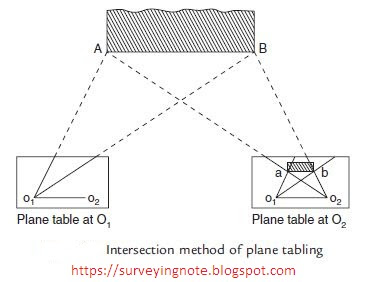 |
| Intersection method |
Traversing Method :
This is pretty much like the compass review. It is utilized for running study lines between stations, which have been recently fixed by different techniques for review, to find the geological subtleties.
The plane table is fixed at an area (state A)
Starting there, a sight is taken toward B and the separation AB is estimated.
The plane table is moved to station B and located toward A (this is gotten back to locating). Separation BA was estimated.
The normal separation among AB and BA are plotted to appropriate scale on the drawing paper.
At that point the point C is located from B and the separation was estimated. This procedure is rehashed for all the stations.
Direct some check at uniform spans. At long last, plot the navigate lines on the drawing sheet. Notice that back locating was done distinctly for the initial two stations.
The plane table is fixed at an area (state A)
Starting there, a sight is taken toward B and the separation AB is estimated.
The plane table is moved to station B and located toward A (this is gotten back to locating). Separation BA was estimated.
The normal separation among AB and BA are plotted to appropriate scale on the drawing paper.
At that point the point C is located from B and the separation was estimated. This procedure is rehashed for all the stations.
Direct some check at uniform spans. At long last, plot the navigate lines on the drawing sheet. Notice that back locating was done distinctly for the initial two stations.
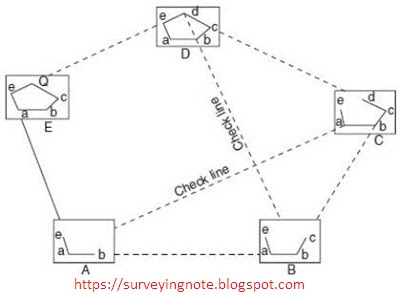 |
| Traversing Method |
Resection Method :
This technique is reasonable for setting up new stations at a spot so as to find missing subtleties. It is the way toward deciding the recently plotted situation of any peg station, by methods for sight taken towards known focuses, the area of which has been plotted.
Resection strategy includes two distinct strategies as follows:
The three-point issue
The two-point issue
Compass Traversing Note -- ReadResection strategy includes two distinct strategies as follows:
The three-point issue
The two-point issue
Chain Surveying Note -- Read
QUESTIONS
AND ANSWER
1 The principle of plane table survey
is
= parallelism
2 The plane table is a drawing board
size
= 750mm * 600mm
3 What are the different type of
alidade?
= plain and telescopic
4 The spirit level is meant for
= leveling
5 What are the different type compass?
= trough compass , circular box
compass
6 The north south direction of a 0
mark both ends is
= trough compass
7 The compass is meant for marking the
north direction is
= circular box compass
8 The meant for centring the table
over a station is
= U-fork with plumb bob
9 Orientation may be done by
= magnetic needle and backsighting
10 The four method of plane table
= radiation, intersection, traversing,
resection
11 Single station method of plane
table
= radiation
12 The method is suitable for locating
inaccessinble points by
= intersection
13 Chain is obstructed but vision free
is method
= intersection
14 The method is suitable for
connecting by
= traversing method
15 The method is suitable locate
missing details by
= resection
16 In plane table survey, the
operation which must be carried out is
= orientation
17 The working edge of the alidade is
known as
= fiducial edge
18 The north line of the map is marked
on the
= right-hand top corner
19 The U-fork and plumb bob are
required for
= centring
20 Inaccessible points may be located
by the
= intersection
21 The accuracy with which the
instrument station can be established is known as
= strength
22 The plane table map cannot be
plotted to a different scale, as
= field book
23 The strength of fix is bad if the
plane table station is taken
= on the circumference
24 The three point problem can be
solved by
= all the methods
25 Intersection method of detailed
plotting is most suitable
= plains
26 The two point problem is a method
of
= none
27 An alidade is used in plane table
surveying for
= drawing line
Thank You...

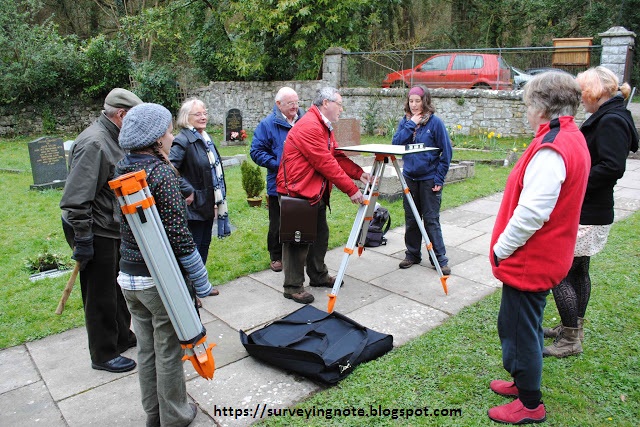
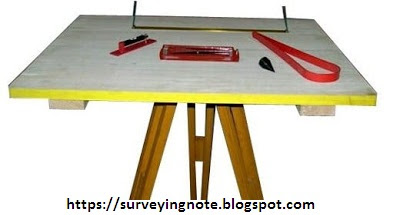
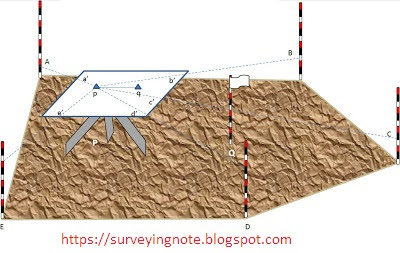












0 Comments:
Post a Comment